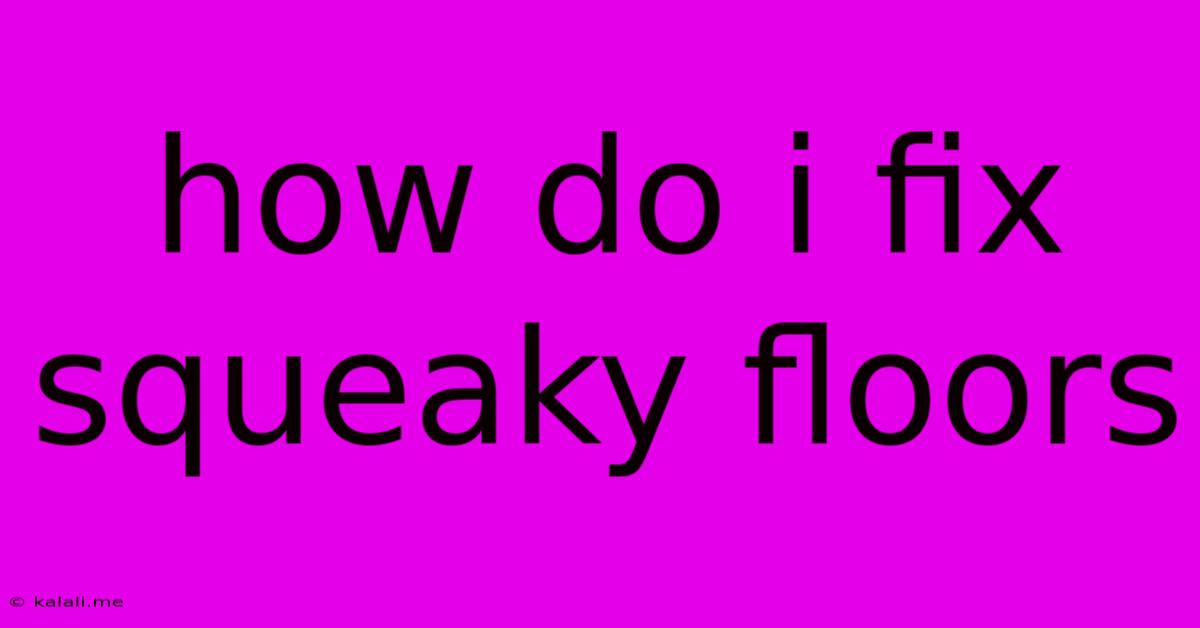How Do I Fix Squeaky Floors
Kalali
May 30, 2025 · 4 min read

Table of Contents
How to Fix Squeaky Floors: A Comprehensive Guide
Meta Description: Learn how to silence those annoying squeaky floors! This guide covers common causes, DIY solutions for hardwood, laminate, and subfloor squeaks, and when to call a professional.
Are you tired of the incessant squeak, squeak, squeak emanating from your floorboards every time someone walks across them? Squeaky floors are a common household annoyance, but thankfully, often a fixable one. This comprehensive guide will walk you through diagnosing the problem and offering several DIY solutions, empowering you to tackle this frustrating issue. We'll cover different flooring types – hardwood, laminate, and even issues with the subfloor – so you can find the perfect solution for your home.
Understanding the Source of the Squeak
Before grabbing your tools, it's crucial to understand why your floors squeak. The most common culprit is friction between floorboards and the supporting structure (joists or subfloor). This friction occurs when the wood shifts, settles, or becomes loose over time. Other factors contributing to squeaky floors include:
- Loose nails or screws: These fasteners can work loose, allowing the floorboards to rub against each other.
- Movement in the subfloor: A shifting or unstable subfloor can transmit squeaks to the finish flooring.
- Improper installation: Poorly installed flooring is a prime candidate for squeaks, especially if the subfloor wasn't properly prepared.
- Changes in humidity: Wood expands and contracts with changes in moisture levels, contributing to movement and squeaks.
- Wear and tear: Years of foot traffic can loosen the connections between flooring and the underlying structure.
DIY Solutions for Squeaky Floors
The good news is that fixing squeaky floors often doesn't require a professional. Here's a breakdown of solutions for various flooring types:
Hardwood Floors:
- Identifying the squeak: Carefully locate the exact spot where the squeak originates. You can often pinpoint this by applying pressure to different areas of the floor while someone walks on it.
- The screw method: If you can access the joists from below (e.g., in a basement), drive a long screw through the subfloor and into the joist directly beneath the squeaky area. This secures the loose board.
- The adhesive method: If access from below isn't possible, apply construction adhesive to the underside of the squeaky board. Carefully lift the board slightly, apply the adhesive along the joist, and firmly press the board back down. Weight it down for several hours to ensure proper adhesion.
- The powdered graphite method: Sprinkle powdered graphite into the crack between boards. Graphite acts as a lubricant, reducing friction. This is a less invasive method, but may not be as effective for persistent squeaks.
Laminate Floors:
Fixing squeaks in laminate flooring is often more challenging as it’s a floating floor. It's generally recommended to avoid drilling into laminate. Instead, consider these options:
- Identify the source: Again, pinpoint the squeaky area. It’s often near the edges where the planks meet.
- Use adhesive: If the squeak originates from the seams, a small amount of construction adhesive can be applied between the planks. Use sparingly and only if you can access the underside of the plank.
- Use shims: For squeaks resulting from gaps between the laminate and the subfloor, carefully insert small wooden shims under the squeaky areas to lift the planks and create a tighter fit.
- Consider replacement: If the squeak is persistent and from a single plank, replacing that individual plank is an option.
Subfloor Issues:
If the squeak appears widespread, the problem might lie within the subfloor itself. This is more complex and often requires more extensive repairs:
- Reinforce the subfloor: This might involve adding additional supports or even replacing sections of the subfloor. This is a job best left to experienced professionals.
- Install a new underlayment: A new layer of underlayment between the subfloor and the finish flooring can sometimes dampen noise and reduce squeaks.
When to Call a Professional
While many squeaky floor fixes are DIY-friendly, some situations require professional help:
- Extensive squeaking: If the squeaking is widespread and persistent, it's best to consult a flooring professional.
- Difficult access: If you can't access the subfloor or joists, professional help is necessary.
- Complex repairs: Subfloor repairs and replacements are best left to experienced contractors.
By understanding the causes of squeaky floors and employing the appropriate solutions, you can restore peace and quiet to your home. Remember to always prioritize safety and don't hesitate to call a professional if the repair seems beyond your capabilities.
Latest Posts
Latest Posts
-
Starter Motor Not Engaging With Flywheel
May 31, 2025
-
Ceiling Fan Pull Chain Switch Diagram
May 31, 2025
-
Connections Between Perturbation Theory And Flucturation Dissipation Theorem
May 31, 2025
-
How Rare Is Getting Struck By Lightning In Minecraft
May 31, 2025
-
Wiring A Ceiling Fan With 3 Wires
May 31, 2025
Related Post
Thank you for visiting our website which covers about How Do I Fix Squeaky Floors . We hope the information provided has been useful to you. Feel free to contact us if you have any questions or need further assistance. See you next time and don't miss to bookmark.